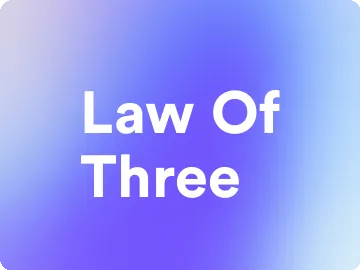Law of Three: Mastering Productivity
This guide will walk you through the essential elements of using law of three - the productivity method to keep your team productive and engaged.
Try Lark for Free
In the fast-paced world of productivity, the "Law of Three" has gained significant attention as a powerful concept for optimizing workflow and achieving efficient results. This article will delve into the depths of the Law of Three, exploring its origins, application, benefits, and potential drawbacks. By the end of this comprehensive guide, you will be equipped with the knowledge and tools to apply the Law of Three effectively in your daily endeavors.
Understanding the Law of Three
The Law of Three is a fundamental principle that centers around the concept that three is the optimal number for cognitive processing and effective decision making. This principle states that working with three items or tasks at a time can significantly enhance productivity and cognitive load management. It implies that dividing tasks or information into three distinct components can streamline processing and decision-making, leading to improved efficiency and reduced mental strain.
What is the Origin of the Law of Three?
The Law of Three traces its origins to psychology, cognitive science, and the field of human factors engineering. It is deeply rooted in the human brain's inherent capacity to process information more effectively when presented in a triadic form. This captivating principle has been studied extensively in various fields and has found applications in diverse domains such as project management, time management, and cognitive psychology.
Who Is the Law of Three For?
The Law of Three is a compelling concept for individuals striving to enhance their productivity and optimize their cognitive resources. From professionals seeking to streamline their workflows to students aiming to improve their study habits, the Law of Three offers valuable insights for anyone looking to achieve more with less effort.
Pros and Cons of the Law of Three
Pros
- Enhanced Focus: By limiting the number of items to three, the Law of Three promotes heightened focus and concentration on essential tasks.
- Streamlined Decision-Making: It simplifies decision-making processes by presenting a manageable number of options, thereby reducing decision fatigue.
- Efficient Task Management: The inherent structure of the Law of Three facilitates efficient task prioritization and organization, leading to enhanced productivity.
Cons
- Oversimplification: In certain scenarios, the rigid adherence to the Law of Three may lead to oversimplification, overlooking complex nuances and considerations.
- Limiting Flexibility: Strictly adhering to the Law of Three may limit adaptability in dynamic situations that require rapid adjustments and multitasking.
Getting Started with the Law of Three
Embarking on a journey to embrace the Law of Three begins with understanding its core principles and integrating them into your daily routine. Here’s how you can kickstart your application of the Law of Three:
-
Identify Key Areas: Begin by identifying the core areas where the Law of Three can be implemented effectively. This could range from task management to decision-making processes.
-
Prioritize Tasks: Select three pivotal tasks or goals to focus on. Prioritize these tasks based on their significance and impact.
-
Structure Information: Break down complex information into three key elements, simplifying how it is processed and absorbed.
-
Evaluate Progress: Regularly evaluate your progress and identify areas where the Law of Three has amplified your productivity and cognitive processing.
Step-by-Step Guide for Implementing the Law of Three
Embracing the Principle
Embrace the fundamental principle of the Law of Three, recognizing its potential to transform your approach to productivity and decision making.
Identifying Key Tasks
Identify the key tasks or elements in your workflow where the Law of Three can be applied to enhance efficiency and focus.
Structuring Information
Break down complex information into three distinct components, ensuring that it aligns with the cognitive advantages of the Law of Three.
Monitoring Progress
Consistently monitor and assess how the Law of Three impacts your productivity and cognitive load management.
Actionable Tips for Leveraging the Law of Three
- Mindful Prioritization: Consistently prioritize tasks based on the Law of Three, aligning your focus with the most impactful elements.
- Visual Representation: Utilize visual aids such as mind maps or diagrams to represent information in threes, aiding in memory retention and processing.
Do's and Don'ts
| Do's | Don'ts |
|---|---|
| Prioritize tasks strategically | Overload yourself with more than three tasks at once |
| Utilize visual aids for clarity | Rigidly adhere to the rule in every single scenario |
| Evaluate and adjust regularly | Disregard the nuanced aspects of complex scenarios |
Conclusion
In conclusion, the Law of Three stands as a profound principle that holds the potential to revolutionize the way we approach productivity and cognitive processing. By understanding its origins, benefits, and potential limitations, individuals can harness the power of the Law of Three to achieve heightened efficiency and decisiveness in their professional and personal pursuits.
Use Lark to unleash your team productivity.
